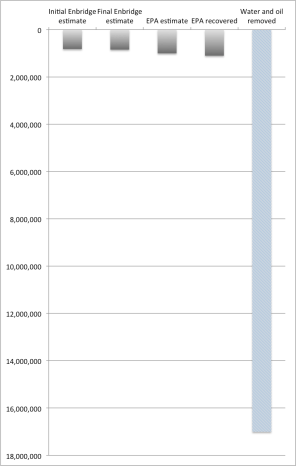
Oil-coated birds from Michigan.
In 2010, a rupture in an Enbridge Energy pipeline dumped hundreds of thousands of gallons of oil sands crude into a tributary of the Kalamazoo River.
When the spill was first reported, Enbridge estimated that 819,000 gallons of oil had escaped. Later, it revised the estimate upward to more than 843,000 gallons.
Those were both low.
The EPA put its official estimate at 1 million gallons. But that’s clearly too low as well, since the agency has already recovered 1.1 million gallons — and it’s not done yet.
In graph form, here’s how the estimates stack up:
The collected oil, in other words, is already 34 percent bigger than Enbridge’s initial estimate.
But there’s another data point worth noting. The EPA has also removed a large amount of contaminated water, water that’s been mixed to some extent with leaked oil. While it’s not clear what the ratio is between water and oil in the mix, so far the agency has removed 17 million gallons of it. So to redo the chart:
Again: that 17 million gallons is not all oil. It’s quite possible that very, very little of the mix is oil. But some of it — an unknown amount — is.
Estimating oil spills (as BP can tell you) is an imprecise science. It would probably be helpful if the science got a whole lot better.





